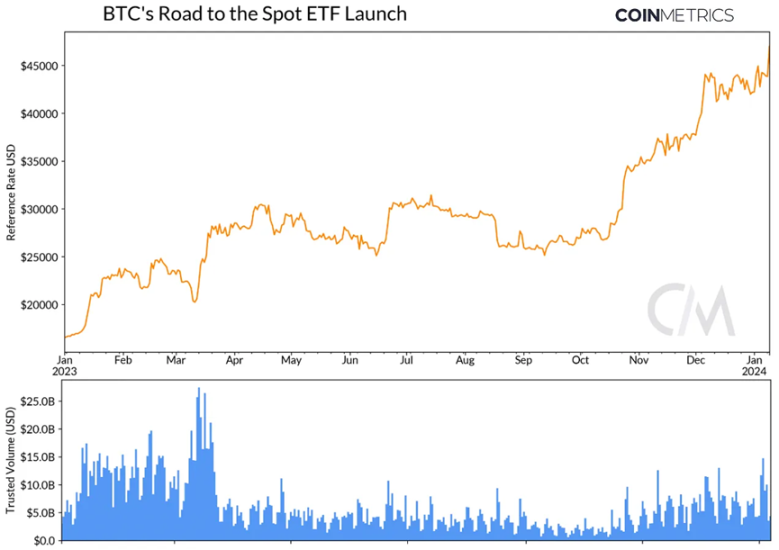Coin Metrics:比特币现货ETF的市场结构
Original author:Tanay Ved
Original compilation: Kate, Mars Finance
Fifteen years have passed since Bitcoins genesis block was mined in 2009, marking the birth of a revolutionary monetary system. The introduction of Bitcoin laid the foundation for the emergence of a $1.6 trillion digital asset economy, becoming many peoples first gateway into the world of blockchain and digital assets. Now, 15 years later, the industry is eagerly awaiting a pivotal moment in Bitcoin’s history: the launch of a spot ETF. As we approach this milestone, we are entering a new phase for the largest crypto asset and network. In this edition of Coin Metrics, we take a deep dive into digital asset market structures and examine the dynamics leading us into this exciting chapter.
The road to ETFs
The process of launching a Bitcoin spot exchange-traded fund (ETF) has been long and challenging, but unprecedented. 2023 marks the beginning of the “Cointucky Derby,” a period characterized by 11 spot ETF applications submitted by leading asset managers and financial institutions including BlackRock, Fidelity, VanEck, and others. We are seeing complex conversations between issuers and the SEC, delving into the operational and structural nuances of proposed ETFs. These discussions revealed key aspects such as the selection of the ETF custodian, the decision to adopt a cash creation model for the redemption mechanism, the fee structure, authorized participants to facilitate the cash creation and redemption process, and consideration of initial capital injections to facilitate inflows.
As the Securities and Exchange Commissions (SEC) Jan. 10 deadline looms, final revisions to S-1 filings highlight a hotly contested fee structure battle: ARK cuts management fee from 0.8% At 0.25%, it competes with Fidelitys 0.39% and BlackRocks 0.2%, while the lowest long-term fee comes from Bitwise at 0.24%. Its clear that issuers are prioritizing market share over short-term profits, suggesting there could be significant demand surrounding the inflows. The industrys anticipation for spot Bitcoin ETFs is palpable, with participants eagerly following every update and issuers strategically positioning themselves to achieve sizable AUM.

Source: Coin Metrics Reference Rates Market Data Feed
This sentiment is reflected in the price of Bitcoin, which surged 156% in 2023. Reliable spot trading volumes rebounded in the first quarter but experienced a period of lull following the Silicon Valley Bank crisis in March. However, trading volumes have begun to pick up again on the back of ETF expectations - now averaging around $10 billion, albeit lower than before the FTX collapse. Bitcoin’s liquidity will also be a key factor in enabling efficient trading of the asset, especially with ETFs on the horizon.
Spot and futures exchange dynamics
The share of Bitcoin spot trading volume across exchanges reveals an increasingly fragmented exchange picture. This is reflected in Binance’s dominance falling from over 75% in the first quarter to below 30% in January 2024. Other exchanges such as Coinbase and Bullish have also benefited from this, leading to a more even distribution of trading volume on centralized exchanges.

Source: Coin Metrics Market Data
Several unanswered questions remain around the role of exchanges, especially given the cost-benefit structure brought about by the launch of spot ETFs. However, investors will now have another way to gain exposure to Bitcoin, which can help meet the risk tolerance of different groups of people. While some may seek a safe and affordable way to invest in Bitcoin, which makes the introduction of ETFs a huge benefit, others may prefer the ability to self-custody Bitcoin, and exchanges can serve as an important portal.

Source: Coin Metrics Market Data Google Finance
The role of onshore exchanges will also be closely watched. However, with Coinbase taking on the role of custodian for the majority of applicants, the largest U.S. exchange may not only benefit from additional revenue streams from its diversified business model, but trading volumes may increase as more players join the fray. Increase. Following the recent rebound in digital asset markets, Coinbase’s average spot trading volume has climbed to over $2.5 billion and is likely to continue to grow as market activity continues.

Source: Coin Metrics Market Data
The derivatives landscape played an important role in shaping the market structure dynamics that preceded ETFs. As CME futures open interest surges to $5.4 billion, we see the digital asset market shifting from being primarily driven by retail investors to a more dynamic institutional playing field. This trend is likely to expand as a host of financial advisors, registered investment advisors (RIAs) and family offices with trillions of dollars in assets under management increasingly incorporate Bitcoin into their traditional investment portfolios.
While the week surrounding ETFs is likely to heighten short-term volatility, as witnessed last week with extraordinary reports that the U.S. Securities and Exchange Commission (SEC) may reject all ETF applications, leading to a sharp decline in open interest, the longer-term outlook paints a brighter picture. A different picture.
Volatility and Return Characteristics
The historical volatility of Bitcoin and other crypto-assets has often been the focus of criticism that views them as high-risk investments. While this is especially true in the early stages, over the longer term Bitcoin’s average realized volatility has trended downwards, suggesting it has evolved into a more mature asset. The chart below shows a similar trend for ETH and SOL, which entered the market at a later stage and exhibited greater volatility relative to BTC. In the world of cryptoassets, it is clear that these assets exhibit varying degrees of volatility and maturity, thereby impacting their overall market structure and role in investment portfolios.

Source: Coin Metrics Market Data
Over a 5-year period, comparing the risk and returns of digital assets to other assets in the investable universe can reveal their role in a portfolio. Traditional assets like gold have the lowest risk and return potential, giving them safe-haven status, and are in a different universe than large-cap stocks like Apple, Microsoft and Amazon. These large-cap stocks all share similar characteristics. On the other hand, the digital assets shown in the chart show distinct characteristics. Bitcoin, the pioneering and largest digital asset, is less volatile than ETH and SOL but offers greater return potential than tech stocks, suggesting it is evolving into a mature yet growth-oriented asset. Additionally, its largely uncorrelated nature with traditional assets further highlights its value in a diversified portfolio and enhances its appeal to investors seeking uncorrelated returns.

Source: Coin Metrics Reference Rates Google Finance
Taken together, these characteristics solidify Bitcoin’s position as the premier, largest and most liquid digital asset for which spot ETF instruments are possible – a testament to its market maturity. Since ETH exhibits similar characteristics, it will be the next to follow.
in conclusion
Bitcoin’s journey from a novel digital currency to a mature, globally recognized network and asset class is almost upon us. The emergence of spot ETFs is an important step in this direction. It is a watershed, ending a decade of exploration, and a critical moment in the evolution of the market. As we enter a new phase as the largest crypto asset, Bitcoin will solidify its importance not only in the realm of the digital asset ecosystem, but also on the global financial stage.



